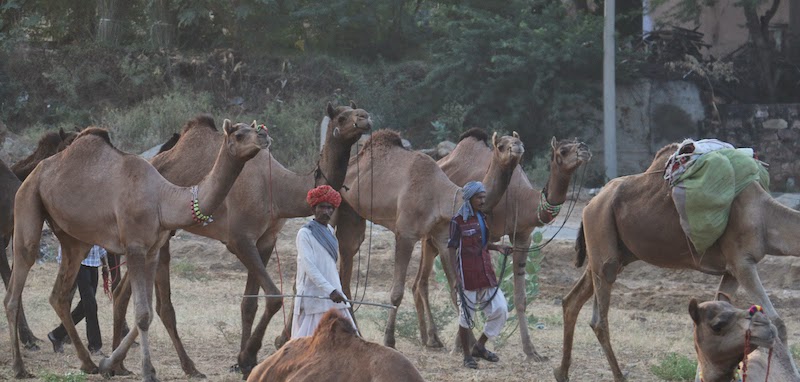 |
| We visited a local home for chai. This is the grandfather and his grandchild. |
 |
| Daughter-in-law making cardamom chai |
 |
| All cooking is done outside |
 |
| The outside of this house was very decorated. |
 |
| Our 3 camel drivers for the week. |
 |
| Camels are painted, decorated and given haircuts to attract buyers. |
 |
| A chai stall. Before sun-up. |
 |
| Keeping warm at the start of another day in the desert. |
 |
| Early morning begins ... |
 |
| The colour of their turban is dependent on whether they are a trader or a buyer. |
 |
| Camel dung is collected, which is pounded into round flat disks and used to fuel campfires. |
 |
| Kisses and smooches. The dark camels (some were really close to black in colour) are a local Rajastani breed. |
 |
| A camel meeting |
 |
| A decorated camel. He's been given a haircut also. |
 |
| Decorating his camel. |
 |
| Friends catching up in the desert. |
 |
| A buyer and his team, watching a camel being put through it's paces. |
 |
| The young camel at the back of the herd fell into the water trough. The result ... 11 photographers got splashed ! |
 |
| More kisses. You can tell a camel's age, by how many teeth it has. They fall out as they get older. |
 |
| A market stall selling camel decorating apparel. |
 |
| Camel dung - flattened, dried and ready for sale. Traders use these patties on their fires to cook and keep warm. |
 |
| Lying down (this is how they sleep) ready for some face painting decoration. |
 |
| Oh boo. An unintentional photo-bomb. |
 |
| Puppets |
 |
| Doorway decorations for sale. |
 |
| A Grey Langur Monkey sitting on a wall at the Savitri Temple. |
 |
| Pushkar Town. Note the Ghat (Pushkar Lake) in the middle frame. |
 |
| Looking down from Savitri Temple at a herd of camels arriving at the fair. |
 |
| More and more camels keep arriving. This space filled with camels within 2 days!!! |
 |
| At the beginning of the climb of 1.5km of steps to the Temple. It gets rougher and steeper on the way up. Most locals drop their shoes along the way and climb bare-feet. |
 |
| This white bull looks like a unicorn with his one horn. The other grew downwards near his ear. |
 |
| Yes, there were a couple of stampedes .... |
 |
| Savitri Temple. We set out at 4am to climb this hill and catch the sunrise. There is a Youtube video from a tourist of the descent. Just watch the first 4-5 minutes to understand the difficulty of this climb !! https://www.youtube.com/watch?v=Zurxyn21h0A Savitri Temple Pushkar is surrounded on three sides by hills. One of the hill is known as Ratnagiri, which houses the Goddess Savitri, the estranged wife of Brahma. The savitri hill is around 750 feet. Pilgrimage to savitri hill is 1.5Kms. It is strenuous and hard. It is believed that harder one tries, the more tapas (heat generated by penance) is gained. When Brahma performed yajna (a ritual sacrifice) at Pushkar, due to unknown reasons Savitri (his wife) could not reach the site at the right time. So Brahma performed yajna accompanied by a local girl, Gayatri – who become his second wife. This annoyed the first wife Savitri and she went to the hilltop. Then the agreement was made that Savitri would always be worshiped first and then Gayatri. Tradition still continues – first arti (hindu ritual of worship) is performed at Savitri temple and then at Gayatri temple. The idols of both Savitri and Gayatri are now installed at the Savitri Temple. |
 |
| When this boy saw us taking photos from our camel cart, he jumped up and started to show off ... !!! |
 |
| Sitting on an awning, painting a sign for his new shop |
 |
| Carnival rides start later in the week, when more tourists start to visit. |
 |
| A baby camel. |
 |
| Even their bottoms are decorated ... |
 |
| All too much for this foal, who fell asleep with the feedbag still strapped on. |
 |
| Showing off for a potential buyer |
 |
| A lady selling millet, for making roti over a campfire (a type of flat bread) |
 |
| Bundles of millet |
 |
| Another herd of camels. This time I was safely out of the way behind a truck!! |
 |
| The group of adventurers!!! |




























































